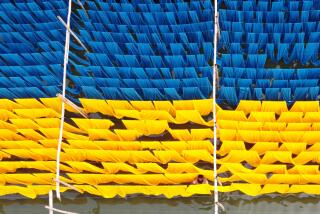Woad, the plant that’s also a DIY blue fabric dye
- Share via
Jamie Jamison remembers her early introduction to woad. She was on a road trip with her parents, stopping at a Stuckey’s shop and seeing a tiny souvenir Navajo rug that illustrated where the natural dyes came from.
She has her own now -- blues, greens and yellows, all grown from her yard. Yellow is easy. Even onion skins will make a usable yellow. Blue, however, is another story. For that she is growing woad, Isatis tinctoria, a member of the mustard family.
Woad originated in southern Europe and western Asia. Commonly known as dyer’s woad, the plant made its name as a source of blue hues.
The Egyptians dyed mummies’ wrapping cloth with woad, and by some accounts, woad was the source for the body paint used by Celtic warriors to confront Roman invaders. Centuries later Medieval European cities grew thanks in part to the profits of the woad trade.
Woad works on wool and cotton, and when combined with the red of madder root, it produces purple. When mixed with the common oxalis, wood sorrel, it makes the warm green favored by Robin Hood.
The plant also contains unusually high quantities of glucobrassicin, GBS, a compound that some believe to has cancer-fighting properties -- the same one found in broccoli.
“It looks like cabbage,” says Jamison, who has documented her woad work on Backyard Dyer, her blog. “It gets shrubby and sends up a seed pod.”
She collects the seeds and keeps control of her crop so it doesn’t spread to her neighbors’ yards. In some places, woad is considered invasive, popping up alongside roadways and in ranch lands.
To extract the dye is a complicated, multiday process. The plant’s leaves are chopped and soaked in alkaline baths. The water is gently extracted with a turkey baster, letting the blue flecks of woad particles settle to the bottom.
“You let it dry out,” Jamison says, holding up a sample of the blue powder. “I get about one tablespoon from a plant. You don’t need tons of it.”
Woad starts easily from seed, available through www.localharvest.com, based in Santa Cruz. The green spinach-like leaves (a favorite of raccoons) are the main harvest for dye and can be cut back several times during a season. The plant over-winters well and sends up a flowering stalk the second year before it fades.
The dye, however, lasts years.
ALSO:
For an easy way to follow the L.A. scene, bookmark L.A. at Home and join us on our Facebook page for home design, our Facebook page for California gardening, Twitter and Pinterest.






